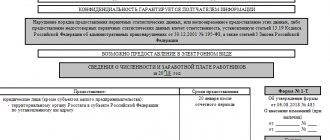Why do you need Form 11 for 2020 in 2020?
Using Form 11, all legal entities, except those related to SMEs and non-profit organizations, must annually report to Rosstat (before April 1 of the year following the reporting year) on the availability and movement of fixed assets and other non-financial assets (NFAs) used in business.
Reports for 2020 must be submitted before 04/01/2020 using the new Form 11, approved by Rosstat Order No. 382 dated 07/04/2019. Its form is available for download on our website below. The instructions for filling out Form 11 were approved by the same Rosstat order No. 382, as well as by order No. 717 dated November 29, 2019.
Reports in 1C: purpose, composition and sections
The purpose of 1C software product reports is to display current information about business transactions in a specific format from a database generated by documents. Documents and Reports in 1C are interrelated and similar to each other, but the function of the Document is to enter data on business transactions into the database, the task of the Report is to display data in a certain format. The Data Composition System (hereinafter referred to as DCS ) made it possible to create reports in a new way. Thus, in the 1C solution version 8.2, the ACS allows you to create reports using the “mouse programming” principle. For these purposes, the program also provides a query constructor. SKD is a system for generating complex reports that provide flexible settings functionality.
Main properties of reports:
- Each report in the 1C has its own screen form;
- One report can have several printed forms;
- The algorithm for creating each report is written in the built-in 1C language;
- Positions in reports are active and can lead to greater detail of the selected object.
Setting up reports in 1C
Self-configuration allows you to get the desired display type. Reports can have their own special configuration form for each type.
Setting algorithm.
In the report form, there is a “Settings” button in the top panel. There are two adjustment options: standard and advanced. The standard version contains presentation modules, rules for grouping rows and columns, and selection options. The extended form requires an indication of general presentation parameters, definition of the grouping format, selection methods and options, makes it possible to enter additional fields, order design and perform sorting according to specified rules.
Standard report form in 1C
Input parameters are grouped into groups:
- Performance indicators;
- Row groupings;
- Selections;
- Column groupings.
Incorrect report setup will result in an empty final form or a large amount of unnecessary information.
How to select data for generating reports?
- In the View, you only need to select the data that the user wants to see in the final form.
- The required indicators must be ticked.
- Specify the details of the data output.
- Determine what results should be in the report.
Data granularity
Parameters, methods and tasks of data detailing:
- Grouping rows and columns.
- Conclusion of general results.
- Output of detailed records.
Grouping can be done by any report attribute. The grouping option shows how to display data in rows and columns in the report. The more choice in the Grouping parameters, the more detailed Reports in 1C the user receives. It is important to set the grouping order correctly, so that, for example, divisions or departments come first, and then employees are indicated within, and not vice versa.
The grouping has the following display methods:
- Element-by-element data output;
- Hierarchical construction of information;
- Hierarchy of records without their details.
Column grouping differs from row grouping only in the direction of granularity, down or to the right.
To work effectively with a database, you need to be able to limit the information displayed. The output data is limited by the period and selection settings. The period setting determines the time interval for displaying information. The Selection functionality will allow you to specify all other relevant restrictions. If you need a non-standard selection, you can customize the Report individually. To do this, you need to add a new Selection option. The possibilities of standard selections are available using the “Quick selections” button; individual selections are called through the settings form.
General recommendations
Before customizing the Report form, you need to present the final version. It is better when the report layout exists in printed form. You should take a report in a form as close as possible to the final format. Configure Reports in 1C according to parameters: period, indicators, analytics section, limitation of information displayed. Setup is the most important stage before the final results are displayed. To make it easy to find the necessary information in the report, you need to correctly group the final data and introduce thoughtful restrictions.
Do you like the article? Subscribe now and receive updates to your email:
| FREE materials for studying the 1C: Accounting 8 configuration (ed. 2 and new ed. 3) |
Similar
Print this article
Filling out Form 11 according to instructions: structure of the reporting document
Form 11 consists of:
- from the title page;
- section 1, which includes information on the availability and structure of fixed assets of the reporting company, changes in their accounting value and depreciation;
- section 2 with information on the availability and movement of the company’s fixed assets by type of activity;
- Section 3, with additional information about the OS, incl. about their average age;
- section 4 with information about fixed assets for which the company does not charge depreciation;
- Section 5, devoted to information about the operating system in separate divisions of the company.
At the end of the document, the full name and position of the company employee authorized to submit reports to Rosstat, his contact information (telephone and email), and his signature are indicated.
Submission of statistical reporting in 2020
Please note that many reporting statistical forms have been developed for almost any economic sector and type of activity. Here we provide tables for statistical reporting relevant in 2020, some of them with deadlines for submission.
| Form | Kind of activity | Subject | Frequency and deadline for submission to Rosstat |
Statistical reporting in 2020, submitted regardless of the type of activity: | |||
| MP (micro) | All types | microenterprises | Annual, February 5 next year |
| PM | All types | small businesses | Quarterly, 29th day after the reporting quarter |
| 1-T | All types | legal entity other than SMP | Annual, January 20 next year |
| 1-T (working conditions) | All types | legal entity other than SMP | Annual, January 19 next year |
| 1-IP | All types except retail trade (excluding motor vehicle trade) | IP | Annual, March 2 next year |
| 1-enterprise | All types, except insurance, banks, government agencies, financial and credit organizations | legal entity other than SMP | Annual, April 1 next year |
| 1-T (working conditions) | All types | legal entity other than SMP | Annual, January 19 next year |
| P-2 | All types | legal entity other than SMP | Quarterly, 20th day after the reporting quarter |
| P-2 (invest) | All types | legal entity other than SMP | Annual, April 1 next year |
| P-3 | All types | Legal entity with a total capital of more than 15 people, except for self-employed enterprises | Monthly, 28th day after the reporting month Quarterly, 30th day after the quarter |
| P-4 | All types | legal entity other than SMP | Monthly, with MSS above 15 people. – 15th of the next month Quarterly, with SSCh 15 people. and less – the 15th day after the reporting quarter |
| P-4 (NZ) | All types | a legal entity with a social capital of more than 15 people, except for self-employed enterprises | Quarterly, 8th day after the reporting quarter |
| P-5 (m) | All types | a legal entity with a social capital of more than 15 people, except for self-employed enterprises | Quarterly, 30th day after the reporting quarter |
| P-6 | All types | legal entity other than SMP | Quarterly, 20th day after the reporting quarter |
| 5-З | All types, except insurance, banks, government agencies, financial and credit organizations | legal entity other than SMP | Quarterly, 30th day after the reporting period (1st quarter, half year, 9 months) |
| All types | legal entity, except SMEs and non-profit organizations | Annual, April 1 next year | |
| 12-F | All types, except insurance, non-state pension funds, banks, government agencies | legal entity other than SMP | Annual, April 1 next year |
| 18-KS | All types | legal entity other than SMP | Annual, February 4 next year |
Submission of statistical reporting in the field of trade: | |||
| PM-bargaining | Wholesale | SMEs, except microenterprises | Monthly, 4th day after the reporting month |
| 1-conjuncture | Retail | legal entity | Quarterly, 15th day of the second month of the reporting quarter |
| 1-conjuncture (wholesale) | Wholesale | legal entity, except micro-enterprises | Quarterly, 10th day of the last month of the reporting quarter |
| 1-removal | Trade | legal entity, except micro-enterprises | Quarterly - on the 5th day after the end of the quarter, annual - on March 1 of the next year |
| 1-TORG | Wholesale and retail trade | legal entity other than SMP | Annual, February 17 next year |
| 1-IP (trade) | Sale of goods to the public, repair of household products | IP | Annual, October 18 of the reporting year |
| 2-RC | Trade in certain goods | Individual entrepreneur and legal entity | Annual, March 30 next year |
| 3-TORG (PM) | Retail | SMEs, except microenterprises | Quarterly, 15th day after the reporting period |
Statistical reporting of organizations providing services: | |||
| 1-IP (services) | Paid services to the population | IP | Annual, March 2 next year, |
| 1-services | Paid services to the population | legal entity, legal entities (except for law offices) | Annual, March 1 next year |
| 1-YES (services) | Services | legal entity, except for microenterprises and non-profit organizations | Quarterly, 15th day of the second month of the reporting quarter |
| 1-manufacturer prices | Manufacturing and services | Individual entrepreneurs and legal entities, except micro-enterprises | Monthly - 22nd of the reporting month, annual - March 11th of the next year |
What reports should be submitted to statistics for those involved in agriculture: | |||
| P-1 (СХ) | Agricultural activities | legal entity, except SMP and peasant farms | Monthly, 3rd day after the reporting month |
| 1-farmer | Sowing crops | SMP, peasant farm, individual entrepreneur | Annual, June 11 of the reporting year |
| 2-farmer | Sowing crops and perennial plantings | SMP, peasant farm, individual entrepreneur | Twice a year on October 2 and November 2, or once a year on November 21 of the reporting year |
| 3-farmer | Availability of farm animals | SMP (monthly), individual entrepreneurs and microenterprises (once a year) | 2nd day after the reporting month, or January 6th after the reporting year |
| 1-purchase prices | Agricultural production | legal entity other than peasant farms | Annual, March 2 next year |
| 2-purchase prices (grain) | Purchase of domestic grain for main production | legal entity | Menstruation, 15th of next month |
| 1-СХ-prices | Agricultural activities | legal entity, except peasant farms and microenterprises | Monthly, 20th of the reporting month |
| 1-СХ (balance) – urgent | Purchase, storage, processing of grain and its processed products | legal entity | Quarterly, 7th day after the reporting quarter |
| 10-MEH (short) | Agricultural activities | legal entity, except peasant farms and microenterprises | Annual, January 20 next year |
| 29-СХ | Agricultural activities in the presence of sown areas, hayfields, or only perennial plantings | legal entity, except SMP and peasant farms | Annual, |
Statistical reporting 2020 - deadlines for the mining industry: | |||
| 1-IP (month) | Extraction and processing; production and distribution of gas, steam, electricity; fishing, logging | Individual entrepreneur with 101 or more employees. | Menstruation, 4th working day of the next month |
| MP (micro) - nature | Individual entrepreneurs and micro-enterprises with up to 15 people. | Annual, January 25 next year | |
| PM-prom | Individual entrepreneurs with employees from 16 to 100 people, small enterprises | Monthly, 4th working day after the reporting month | |
| 1-nature-BM | legal entity other than SMP | Annual, February 10 next year | |
| DAP-PM | Mining, manufacturing, air conditioning, gas, steam, electricity | small businesses | Quarterly, 10th of the last month of the quarter |
| 1-DAP | legal entity other than SMP | Monthly, 10th of the reporting month | |
| IAP | Mining, manufacturing, air conditioning, gas, steam, electricity, water supply, sanitation, waste collection and disposal, pollution removal | legal entity, except micro-enterprises | Annual, October 10 of the reporting year |
List of statistical reporting for the oil and gas industry: | |||
| 1-TEK (oil) | Production of oil, associated gas and gas condensate | legal entity other than SMP | Annual, January 28 next year |
| 1-TEK (drill) | Drilling of the wells | legal entity other than SMP | Annual, January 28 next year |
| 2-TEK (gas) | Availability of gas wells on the balance sheet | legal entity other than SMP | Annual, January 28 next year |
| 6-oil | Oil production and refining | legal entity other than SMP | Quarterly, 30th |
| 1-motor gasoline | Production of motor gasoline and diesel fuel | legal entity other than SMP | Weekly, 1 day after the reporting week, until 12 noon. |
Construction statistics - reports in 2020: | |||
| DAS | Construction | legal entity, except micro-enterprises | Quarterly, 10th day of the second month of the reporting quarter |
| 9-KS | Construction | legal entity, except micro-enterprises | Monthly, 25th of the reporting month |
| 12-construction | Construction | legal entity other than SMP | Annual, January 15 of the current year |
Statistical reporting of transport enterprises: | |||
| 65-ETR | Operation and maintenance of urban electric transport | legal entity | Annual, January 25 next year |
| 65-autotrans | Transportation of passengers by buses and passenger taxis | legal entity, except micro-enterprises | Annual, February 10 next year |
| 1-TR (motor transport) | Transportation of goods by road; non-public roads on the balance sheet | legal entity, except micro-enterprises | Annual, January 25 next year |
| 11-GA | Air transportation | legal entities and their separate divisions | Quarterly, 15th day after the reporting quarter |
| 12-GA | Monthly, 7th day after the reporting quarter | ||
| 14-GA | Monthly, 15th day after the reporting quarter | ||
| 32-GA and 33-GA | Quarterly, 7th day after the reporting quarter | ||
| 1-TARIFF (auto), 1-TARIFF (ha), 1-TARIFF(more), 1-TARIFF (yellow), 1-TARIFF (pipe), 1-TARIFF (internal water) | Transportation of goods by road, air, sea, railway, pipeline, water transport | legal entity | Monthly, 23rd of the reporting month |
Sections 1 and 2 (information about the availability and composition of the OS)
Section 1 of Form 11 is a table. It records indicators that correlate with numbers reflecting:
- adjustment of the full accounting value of the object as a result of revaluation as of the end of the reporting period or as a result of a decrease in the value of assets;
- increase or decrease in the total accounting value of the object;
- availability of the object at the end of the year at full accounting value, adjusted for revaluation, which was carried out at the end of the reporting period, as well as adjusted for impairment of assets;
- availability of the object at the end of the year at the residual book value, adjusted for revaluation, which was carried out at the end of the year, as well as adjusted for impairment of assets;
- accounting depreciation of fixed assets accrued during the reporting year;
- depreciation of fixed assets;
- accounting depreciation, which relates to liquidated fixed assets.
These indicators are presented both in relation to all fixed assets available during the reporting year, and broken down into groups represented by real estate, machinery and equipment, inventory, plantings, working and productive livestock, and intellectual property.
In section 2, information from line 01 of section 1 is detailed by type of activity in which it is used: in line 15 by the total amount, in lines 16-18 by type of activity. If there are more than three businesses, lines 18-1, 18-2, etc. are filled in.
P 1 statistics
"Chief Accountant". Appendix “Production Accounting”, N 4, 2004
HOW TO FILL OUT THE NEW FORM N P-1
Starting from the new year, enterprises will report to statistical authorities using new forms. In particular, Form N P-1 “Information on the production and shipment of goods and services” has been changed. Now it has been approved by Rosstat Resolution No. 34 of July 27, 2004. For the first time, industrial enterprises will have to submit this form no later than February 4, 2005.
————————————————————————————————— The document was published in the section “Regulatory framework/new documents” on p. 95.
The article explains how to fill out each section of Form N P-1.
Title page
On the title page the company indicates information about itself.
Here the accountant must reflect the period for which the report is presented. Next, you need to write down the full name of the enterprise, which appears in the constituent documents.
In addition, the title page must contain data on the postal address and OKPO code of the enterprise. Information on the OKPO code is taken from the information letter of the statistical authorities on the assignment of the corresponding codes.
Section 1. General economic indicators
It’s worth saying right away that all industrial enterprises will have to fill out this section. On line 1, they provide data on the total volume of shipment of goods of their own production, work and services performed on their own in actual prices without VAT, excise taxes and other similar payments. Data are presented for the reporting month, for the previous month and for the corresponding month of the previous year.
The volume of goods shipped represents the cost of those goods that were actually transferred to consumers in the reporting period, regardless of whether money was credited to the seller’s account or not.
Thus, the moment of shipment in wholesale trade may be the release of products to the buyer or a third-party transport organization from the seller’s warehouse or the delivery of products to the buyer’s warehouse.
Line 2 indicates the volume of sales of goods not produced in-house.
Line 3 shows the balances of finished products of own production at the end of the month. In our opinion, such products should still be valued at average selling prices.
Line 5 indicates the balance of goods for resale at the end of the month. Line 6 reflects the quantity of manufactured industrial products, which were included in fixed assets in the reporting period.
Line 7 shows the cost of construction and installation work on buildings and structures that were completed on an economic basis.
It is worth saying that all industrial enterprises put dashes on lines 8 and 9 (they are intended for agricultural enterprises).
Line 10 shows the cost of processed customer-supplied raw materials and materials.
Line 11 takes into account the cost of raw materials and materials that are transferred for processing to other legal entities and individuals.
Line 12 details the revenue that the company showed on line 01. Now the accountant shows only the revenue that comes from shipped goods (works and services) of an innovative nature.
Please note: innovations do not include aesthetic, as well as minor technical or external changes in the product, which left its design unchanged and did not have a sufficiently noticeable impact on the parameters (in particular, the properties, cost of the product).
Also, innovative products do not include new products of an enterprise that have been produced by other organizations for a long time.
Line 13 shows the total volume of orders (contracts) for the supply of products in subsequent periods. This order is formed on the basis of concluded contracts, regardless of the deadline for their execution, minus completed and canceled contracts. The volume of orders is given in the prices established in the contracts.
The data on line 13 is detailed in line 14. In it, the accountant should show future export deliveries.
Example. OJSC "New Metallurgical Company" is engaged in the production of steel pipes and fittings.
To simplify the example, let's assume that it only started operations in January 2005.
In January 2005, steel pipes worth RUB 10,000,000 were produced and shipped.
In addition, auxiliary production produced and shipped equipment for the food industry worth RUB 1,500,000. Part of it was transferred to the factory canteen in the amount of 200,000 rubles.
The transport workshop provided external services for the transportation of goods for 700,000 rubles. In January, the cost of services for processing customer-supplied raw materials amounted to 250,000 rubles. The cost of processed customer-supplied raw materials is 400,000 rubles.
The total volume of orders for the next months is 11,000,000 rubles, including for export - 8,000,000 rubles.
The completed Section 1 of Form N P-1 for January 2005 at OJSC New Metallurgical Company looks like this:
(thousand roubles.)
——————————————————————————————————————————T——————T —————————T———————T—————————¬ | Indicator name | N |For from— |For pre—|For according— | | |lines|even |previous|due— | | | |month |month |monthly— | | | | | |since past—| | | | | |logo of the year| +—————————————————————————————————————————+—————+ —————————+———————+—————————+ | A | B | 1 | 2 | 3 | +—————————————————————————————————————————+—————+ —————————+———————+—————————+ |Own goods shipped| 01 |12 250 | — | — | |production, works and services performed| |(10,000 +| | | |on our own | |1500 - | | | | | |200 + | | | | | |700 + | | | | | |250) | | | +—————————————————————————————————————————+—————+ —————————+———————+—————————+ |… | ... | ... | ... | ... | +—————————————————————————————————————————+—————+ —————————+———————+—————————+ |Industrial products produced,| 06 | 200 | — | — | |enrolled in the reporting period in the main| | | | | | means | | | | | +—————————————————————————————————————————+—————+ —————————+———————+—————————+ |…
| ... | ... | ... | ... | +—————————————————————————————————————————+—————+ —————————+———————+—————————+ |Cost of processed tolling| 10 | 400 | — | — | | raw materials | | | | | +—————————————————————————————————————————+—————+ —————————+———————+—————————+ |… | ... | ... | ... | ... | +—————————————————————————————————————————+—————+ —————————+———————+—————————+ |Total volume of orders (contracts) for| 13 | 11,000 | x | x | |delivery of products in subsequent periods| | | | | |at the end of the month: | | | | | +—————————————————————————————————————————+—————+ —————————+———————+—————————+ | including for export | 14 | 8,000 | x | x | L—————————————————————————————————————————+—————+ —————————+———————+——————————
In addition, Section 1 provides reference data on the export, import of services and export of goods to the Republic of Belarus.
Section 2.
Self-produced goods shipped,
works and services were performed using our own resources
by actual activities
This section details information on the cost of shipped products of our own production. So, for each type of product it is necessary to record how much of it was shipped in the reporting month, last month and for the corresponding month of last year.
The cost of shipped products is determined in selling prices excluding VAT, excise taxes and other similar payments.
Section 4. Cargo transportation and cargo turnover
road transport
This section is filled out by enterprises that transport goods using their own or rented vehicles. In this case, it does not matter how the organization transported the goods. She can do this on any truck.
In section 4, the enterprise shows information about the amount of cargo transported (line 29) and cargo turnover (line 31).
In addition, you need to separately show data on commercial transportation. Such data is given on line 30 (amount of cargo transported) and line 32 (freight turnover).
Section 5. Production and shipment
by type of product and service
This section provides production and shipment data by type of product and service. Moreover, the type of products and services for which it is necessary to report is established by the statistics body.
It is worth noting that not all columns of this table need to be filled in for each row. So, on the line where the enterprise will provide data on manufactured industrial products, you need to fill in only columns B, C, D, 1 - 5. In this case, in column B the accountant must write down code 50.
V.V.Yakovlev
Auditor
"Check audit"
Signed for seal
04.10.2004
—————————————————————————————————————————————————————————————————— ———————————————————— ——
Section 3 (Additional OS Information)
The main element of this section is also the table. It shows:
- the volume of profitable investments in material assets (line 19);
- the cost of fixed assets that are taken into financial lease when recorded on the lessee’s balance sheet (line 20);
- the cost of fixed assets that are leased and are recorded on the lessor’s balance sheet (line 21);
- cost of OS for environmental protection (line 22).
Read about the characteristics that determine the differences between rent and financial lease (leasing) in the material “What is the difference between rent and leasing?” .
Below is the amount of investments in fixed assets made in the reporting year (line 23).
The table below shows:
- average annual total accounting value of fixed assets (line 24);
- the cost of the actual sale of fixed assets to other organizations and individuals (except for sales for the purpose of liquidation) (line 25);
- the cost of costs for work in progress equipment and vehicles intended for internal use (line 26);
- the cost of equipment to be installed in the company (line 27);
- the amount of costs related to the unfinished construction of real estate for internal use or paid by the customer (line 28).
Lines 29-32 indicate the average age of fixed assets by type, and lines 33-37 indicate the year in which fixed assets are primarily taken into account in prices.
Section 5 (OS by territorial divisions)
Section 5 of Form 11 reflects data on fixed assets at the disposal of separate divisions of the reporting company, which are located in the same subject of the Russian Federation with the head office. Fixed:
- OKPO;
- data on the average annual full accounting value of fixed assets in the division.
Fill out as many copies of Section 5 sheets as there are divisions of the reporting company, including those that do not have OS.
You can download a sample of filling out Form 11 on our website.
What is Form Statistics 11 (Transaction)
Along with Form 11, according to which companies submit to Rosstat information on the availability and movement of all fixed assets and non-current assets during the reporting year, there is Form 11 (transaction), through which organizations inform the department about transactions with fixed assets on the secondary market, as well as about the delivery of the corresponding OS for rent.
For information on how accounting is organized for the tenant and the lessor, read the article “Accounting for the lease of fixed assets (nuances)” .
In addition to its purpose and structure, Form 11 (transaction) differs from Form 11 in that:
- it must be submitted to Rosstat by all legal entities not related to microenterprises (including small and medium-sized enterprises and non-profit organizations);
- it must be submitted on a different date - before June 30 of the year following the reporting year (for 2020 - before 06/30/2020).
Form 11 (transaction) in the version that must be used to prepare the report for 2020 was also approved by Rosstat order No. 382 dated July 4, 2019.
You can download it on our website:
Statistical reporting of budgetary institutions
If a legal entity has separate divisions, this form is filled out both for each separate division and for a legal entity without these separate divisions.
Also, organizations should not forget that they must all submit financial statements to Rosstat at the end of the year. It is submitted to statistics after it is accepted by the tax authorities, that is, with a mark of acceptance by them.
In the construction industry, at any given moment, products are at different stages of readiness, depending on the volume and composition of work performed since the beginning of the construction of objects. To correctly determine the volume of construction products c. Under these conditions, it is necessary to take it into account at each stage of readiness.
In addition to tax reporting, legislative acts provide for the obligation of a business entity to submit reports to statistics. Which forms to submit are determined by Rosstat independently and communicated to companies and entrepreneurs. Currently, there is a service where you can use your tax identification number (TIN) to view reports to statistics in 2020, a list of forms and deadlines for submission.
https://youtu.be/eXYQbgvzxdM
This must be done no later than April 16, 2018. Annual financial statements must be submitted to the tax office no later than three months after the end of the reporting period (subclause 5, clause 1, article 23 of the Tax Code of the Russian Federation). At the same time, a mandatory copy of the annual reporting must be submitted to the statistics department (Part 2 of Article 18 of the Law of December 6, 2011 No. 402-FZ). For those partnerships that enjoy this right, the financial statements consist of the following: Moreover, you need to use the simplified forms of these documents given in Appendix 5 to Order of the Ministry of Finance of Russia dated July 2, 2010 No. 66n.
Rosstat, by its order No. 5 dated January 12, 2018, approved new instructions for filling out statistical form No. C-1 “Information on the commissioning of buildings and structures.”
We need to weigh and evaluate everything, but for now we can start working on it in large cities,” he clarified.
Results
Form 11 is a document submitted annually to Rosstat by legal entities not related to NPOs or SMPs. It records information about the fixed assets of the organization and its territorial divisions. Its complementary report is Form 11 (transaction), reflecting information about transactions with fixed assets carried out on the secondary market.
About statistical form 11 (short), submitted by non-profit organizations, read the article “Procedure and sample for filling out form No. 11 short (nuances).”
Sources:
- Order of Rosstat dated July 4, 2019 No. 382
- Order of Rosstat dated November 29, 2019 No. 717
You can find more complete information on the topic in ConsultantPlus. Full and free access to the system for 2 days.








